|
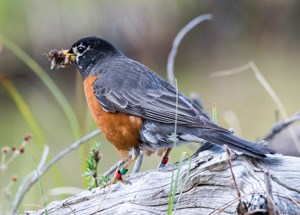
NPS Photo / J. Gaposchkin American RobinAmerican robins are one of the most commonly seen birds in North America. Denali National Park scientists are tracking their migration through the Critical Connections project. American robins live in Denali during the late spring, summer, and early fall. Look for them in forested areas, such as the park entrance and lower-elevation river valleys throughout the park. 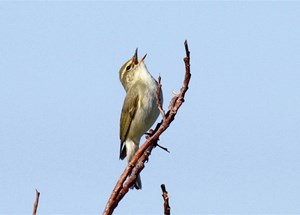
NPS Photo / K. Zimmer Arctic WarblerArctic warblers almost exclusively spend their summers in Alaska. They use grass, leaves, and moss to create domed-shaped nests on the ground. Arctic warblers spend the winter in eastern Eurasia. Their migration journey is studied through the park's Critical Connections project. Arctic warblers breed in Denali during the late spring, summer, and early fall. They prefer thickets of willow, birch, and alder, near streams. Many such areas can be found near the Denali Park Road between Savage River (Mile 15) and Teklanika River (Mile 30), as well as creeks around Toklat River (Mile 53). 
NPS Photo Black-billed MagpieBlack-billed magpies range across western North America. They build distinct large, globular nests out of sticks and twigs. Black-billed magpies stay in Denali year-round. They are most commonly found in streamside groves and developed areas. 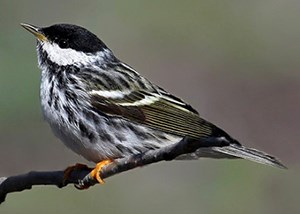
NPS Photo / Nick Saunders Blackpoll WarblerBlackpoll warblers take an incredible migratory journey each fall. They travel from Denali National Park to South America, often flying nonstop for over 72 hours. Blackpoll warbler migration is being monitored through the park's Critical Connections program. Blackpoll warblers call the park home in the late spring, summer, and early fall. Find them nesting in the boreal forest or alder thickets. Such areas can be found throughout most of the first 40 miles of the park road, as well as the western-most 15 miles of the road. 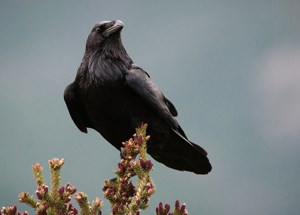
NPS Photo Common RavenCommon ravens are incredibly adaptable. They live in habitats from tundra to desert across North America. Visitors often hear their croaking call. Common ravens stay in Denali year-round. They can be found in the boreal forest or open tundra. 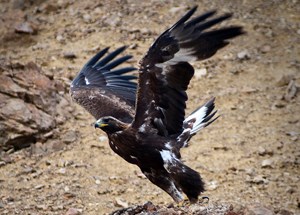
NPS Photo Golden EagleGolden eagles are an apex predator, hunting everything from ptarmigan to snowshoe hare. A golden eagle in Denali may travel over 250,000 miles in its lifetime. Park researchers study the habitat, migration, and behavior of these magnificent birds. Golden eagles nest in Denali during mid-spring to late fall. Look for them on the open tundra or steep cliffs, like Polychrome Mountain (~ Miles 45 to 51) and near Eielson Visitor Center (Mile 66). 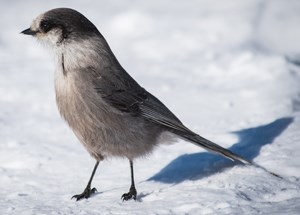
NPS Photo Canada JayCanada jays are some of the hardiest residents of Denali National Park. They store extra food in scattered caches to feed off during the winter. Park research on Canada jays has revealed more about these birds and how they may be influenced by climate change. Canada jays can be seen year-round in Denali. You can find them in the boreal forests. Most of the entrance area of Denali is boreal forest, as well as many river valleys throughout the park. 
NPS Photo GyrfalconGyrfalcons are powerful arctic predators. They may start laying eggs as soon as late winter. Park scientists are studying gyrfalcons to better understand their life cycle. Gyrfalcons live in Denali year-round. They prefer open tundra for hunting and steep cliffs for nesting sites. Open tundra occurs at any elevation in the park above about 3,200', such as between Toklat River (Mile 53) and Eielson Visitor Center (Mile 66). 
NPS Photo Long-tailed JaegerLong-tailed Jaegers spend most of their lives over the open ocean. They gather to the tundra of Denali however, to find mates and nest. Denali park scientists collaborate with The Migratory Connectivity Project to GPS tag and map long-tailed jaeger migration. Long-tailed jaegers arrive in the park in late spring and remain until fall. They are usually spotted hunting or nesting in the open tundra. Open tundra occurs at any elevation in the park above about 3,200', such as between Toklat River (Mile 53) and Eielson Visitor Center (Mile 66). 
NPS Photo Northern Hawk OwlNorthern hawk owls live in remote northern regions of North America. Unlike many owls, they mainly hunt by day. They use their sharp eyesight and hearing to catch rodents and small birds. Northern hawk owls are permanent residents of Denali. Look for them in open forested areas and around the edges of clearings. Some likely spots are the edges of forests along the Sanctuary and Teklanika Rivers. 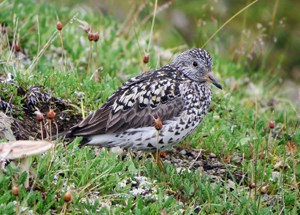
NPS Photo / Dan Gusset SurfbirdSurfbirds spend the winter on rocky coastlines stretching from southeast Alaska to southern Chile. They migrate to localized areas in Alaska each summer however to breed and raise their young. Surfbirds can be seen in Denali during the summer. They build their nests in rocky tundra, often above the tree line. Any of the mountains on the north side of the Denali Park Road are good areas to search. 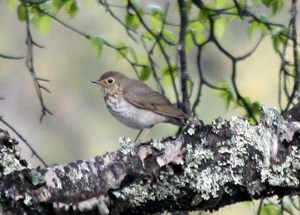
NPS Photo Swainson's ThrushSwainson's thrush travel to Denali from rainforests in Central and South America. Their migration pathway is studied through the park's Critical Connections project. Swainson's thrush reside in Denali late spring to mid-fall. They can usually be found in forested areas with dense undergrowth. Anywhere low-elevation area between the park entrance and Park Headquarters (Mile 3) is a decent place to look, particularly some of the lower stretches of the Triple Lakes Trail. 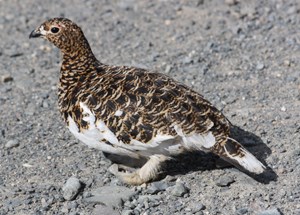
NPS Photo Willow PtarmiganWillow ptarmigans are one of the mostly commonly noticed birds on the Denali Park Road. These camouflaged birds molt their feathers twice a year - going from white in winter to brown in the summer. Park research has shown that willow ptarmigan population varies in cycles. Willow ptarmigans live in Denali year-round. They are usually spotted in wet tundra, near willow scrub. The hills south of the park road between Savage River (Mile 15) and Sanctuary River (~ Mile 22) are good areas to search, although their favored terrain usually makes for uncomfortable hiking. It's also not uncommon to see ptarmigan on the side of the park road in many different areas. |
Last updated: June 3, 2019
